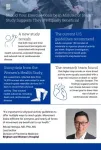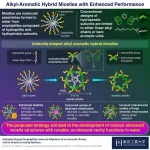(Press-News.org) In the age of smartwatches, monitoring step counts has never been easier, but current physical activity guidelines do not explicitly recommend specific step counts for health. A new study from researchers at Brigham and Women’s Hospital, a founding member of Mass General Brigham, suggests that both step and time-based exercise targets are equivalently associated with lower risks of early death and cardiovascular disease. Thus, whether one chooses a time or step goal may not be as important as choosing a goal aligned with personal preferences. Results are published in JAMA Internal Medicine.
Physical activity reduces the risk of acquiring chronic illness and infection, and promotes longevity. The current U.S. guidelines, last updated in 2018, recommend that adults engage in at least 150 minutes of moderate to vigorous physical activity (e.g., brisk walking) or 75 minutes of vigorous activity (e.g., jogging) per week. At that time, most of the existing evidence on health benefits came from studies where participants self-reported their physical activity. Few data points existed on the relationship between steps and health. Fast forward to the present – with wearables being ubiquitous, step counts are now a popular metric among many fitness tracking platforms. How do time-based goals stack up against step-based ones? Investigators sought to answer this question.
“We recognized that existing physical activity guidelines focus primarily on activity duration and intensity but lack step-based recommendations,” said lead author Rikuta Hamaya, MD, PhD, MS, a researcher in the Division of Preventive Medicine at BWH. “With more people using smartwatches to measure their steps and overall health, we saw the importance of ascertaining how step-based measurements compare to time-based targets in their association with health outcomes – is one better than the other?”
For this study, investigators collected data from 14,399 women who participated in the Women’s Health Study, and who were healthy (free from cardiovascular disease and cancer). Between 2011 and 2015, participants aged 62 years and older were asked to wear research grade wearables for seven consecutive days to record their physical activity levels, only removing the devices for sleep or water-related activities. Throughout the study period, annual questionnaires were administered to ascertain health outcomes of interest, in particular, death from any cause and cardiovascular disease. Investigators followed up with participants through the end of 2022.
At the time of device wear, researchers found that participants engaged in a median of 62 minutes of moderate-to-vigorous intensity physical activity per week and accumulated a median of 5,183 steps per day. During a median follow-up of 9 years, approximately 9% of participants had passed and roughly 4% developed cardiovascular disease. Higher levels of physical activity (whether assessed as step counts or time in moderate-to-vigorous activity) were associated with large risk reductions in death or cardiovascular disease – the most active quarter of women had 30-40% risk reductions compared with the least active quarter. And, individuals in the top three quartiles of physical activity outlived those in the bottom quartile by an average of 2.22 and 2.36 months respectively, based on time and step-based measurements, at nine years of follow-up. This survival advantage persisted regardless of differences in body mass index (BMI).
While both metrics are useful in portraying health status, Hamaya explained that each has its advantages and downsides. For one, step counts may not account for differences in fitness levels. For example, if a 20-year-old and 80-year-old both walk for 30 minutes at moderate intensity, their step counts may differ significantly. Conversely, steps are straightforward to measure and less subject to interpretation compared to exercise intensity. Additionally, steps capture even sporadic movements of every day life, not just exercise, and these kinds of daily life activities likely are those carried out by older individuals.
"For some, especially for younger individuals, exercise may involve activities like tennis, soccer, walking, or jogging, all of which can be easily tracked with steps. However, for others, it may consist of bike rides or swimming, where monitoring the duration of exercise is simpler. That's why it's important for physical activity guidelines to offer multiple ways to reach goals. Movement looks different for everyone, and nearly all forms of movement are beneficial to our health,” said Hamaya.
The authors note that this study incorporates only a single assessment of time and step-based physical activity metrics. Further, most women included in the study were white and of higher socioeconomic status. Finally, this study was observational, and thus causal relations cannot be proven. In the future, Hamaya aims to collect more data via a randomized controlled trial to better understand the relationship between time and step-based exercise metrics and health.
Senior author I-Min Lee, MBBS, ScD, an epidemiologist in the Division of Preventive Medicine at BWH, concluded, "The next federal physical activity guidelines are planned for 2028. Our findings further establish the importance of adding step-based targets, in order to accommodate flexibility of goals that work for individuals with differing preferences, abilities and lifestyles."
Authorship: In addition to Hamaya, BWH authors include Julie E. Buring and I-Min Lee. Additional authors include Eric Shiroma, Christopher Moore, and Kelly Evenson.
Disclosures: The authors declare no competing interests.
Funding: This research was supported in part by the National Institutes of Health (CA154647, CA047988, CA182913, HL043851, HL080467, and HL09935), from the; National Cancer Institute (5R01CA227122), Office of the Director, Office of Disease Prevention, and Office of Behavioral and Social Sciences Research; and by the extramural research program at the National Heart, Lung, and Blood Institute.
Paper cited: Hamaya R. et al. “Time vs. Step-Based Physical Activity Metrics for Health.” JAMA Internal Medicine DOI: 10.1001/jamainternmed.2024.0892
END
Should your exercise goals be in minutes or steps? Study suggests they are equally beneficial
New research from Brigham and Women’s Hospital researchers reveals that both step and time-based exercise targets are equivalently associated with improved health outcomes, extended lifespan, and reduced risk of cardiovascular disease
2024-05-20
ELSE PRESS RELEASES FROM THIS DATE:
Racial and ethnic inequities in cancer care continuity during the COVID-19 pandemic among those with SARS-CoV-2
2024-05-20
About The Study: In this cross-sectional study of patients with cancer and SARS-CoV-2, racial and ethnic inequities existed in treatment delays and discontinuations throughout the pandemic; however, the disproportionate burden among racially and ethnically minoritized patients with cancer varied across SARS-CoV-2 waves. These inequities may lead to downstream adverse impacts on cancer mortality among minoritized adults in the United States.
Corresponding Author: To contact the corresponding author, Jessica Y. Islam, Ph.D., M.P.H., email jessica.islam@moffitt.org.
To access the embargoed study: Visit our For The Media website at this link https://media.jamanetwork.com/
(doi:10.1001/jamanetworkopen.2024.12050)
Editor’s ...
Effect of sleep restriction on adolescent cognition by adiposity
2024-05-20
About The Study: Adolescents with overweight or obesity may be more vulnerable to negative cognitive effects following sleep restriction. Improved sleep hygiene and duration in this group may positively impact their cognitive health.
Corresponding Author: To contact the corresponding author, Aaron D. Fobian, Ph.D., email afobian@uabmc.edu.
To access the embargoed study: Visit our For The Media website at this link https://media.jamanetwork.com/
(doi:10.1001/jamaneurol.2024.1332)
Editor’s ...
Webb Telescope offers first glimpse of an exoplanet’s interior
2024-05-20
A surprisingly low amount of methane and a super-sized core hide within the cotton candy–like planet WASP-107 b.
The revelations, based on data obtained by the James Webb Space Telescope, mark the first measurements of an exoplanet’s core mass and will likely underpin future studies of planetary atmospheres and interiors, a key aspect in the search for habitable worlds beyond our solar system.
“Looking into the interior of a planet hundreds of light-years away sounds almost impossible, but when you know the mass, radius, atmospheric composition, and hotness of its interior, you’ve got ...
Alkyl-aromatic hybrid micelles formed from emergent umbrella-shaped molecules
2024-05-20
Micelles assemble in water from amphiphilic molecules, composed of hydrophilic and hydrophobic frameworks. They can be found all around us, for example in soaps, detergents, and shampoos. Their main application is the water-solubilization of insoluble molecules through encapsulation into hydrophobic cavities. These cavities are conventionally composed of linear alkyl-chains, providing good interactions with alkyl-based guests, yet poor interactions with aromatic compounds. In addition, the rather weak intermolecular alkyl-alkyl type ...
First study from the African Ancestry Neuroscience Research Initiative identifies key genes in the brain that account for higher rates of some brain disorders in Black Americans
2024-05-20
BALTIMORE, Md. (May 20, 2024) – Scientists seeking to counter the neglect of African Americans in neuroscience research have found evidence that genetic ancestry is responsible for the increased prevalence of certain neurological disorders, such as Alzheimer’s disease and stroke, and decreased prevalence of others, including Parkinson’s disease, in Black Americans, according to new research published May 20 as the June cover story in the journal Nature Neuroscience.
In contrast, the scientists from the Lieber Institute for Brain Development did not find evidence that genetic ancestry is responsible for differences in the ...
NIH awards Coast-to-Coast Consortium $5.6 million for All of Us Research Program
2024-05-20
Researchers at the University of California San Diego have been awarded a $5.6 million grant through the Coast-to-Coast Consortium (C2C) to further their pioneering efforts with the National Institutes of Health's (NIH) All of Us Research Program.
The award is designated to facilitate participant engagement, enrollment, data collection, and retention. C2C will build on the foundation set by the UCSD-led California Precision Medicine Consortium (CAPMC), established in 2018, which enrolled more than 65,500 participants to the program.
This award follows the program's ...
Ben-Gurion University scientist hunts for drug candidate to treat brain tumors
2024-05-20
BEER-SHEVA, Israel, May 20, 2024 – When you disable the brakes on a race car, it quickly crashes. Dr. Barak Rotblat wants to do something similar to brain cancer cells. He wants to disable their ability to survive glucose starvation. In fact, he wants to speed the tumor cells up, so they just as quickly die out. It is a novel approach to brain cancer based on a decade of research in his lab.
He and his students' and co-lead researcher Gabriel Leprivier of the Institute of Neuropathology at University Hospital Düsseldorf ...
New Health Blueprint maps healthier future for rural, underserved Southwest Virginia
2024-05-20
A sweeping new Health Blueprint for Southwest Virginia highlights the grave health challenges that grip the rural region but also proposes solutions to help residents live longer, healthier lives.
The Blueprint was assembled by the University of Virginia College at Wise’s Healthy Appalachia Institute, the Southwest Virginia Health Authority, UVA Health’s Center for Telehealth and a coalition of residents and regional healthcare providers. The document identifies priority health concerns for the three health districts in the southwestern corner of Virginia: Lenowisco, Cumberland Plateau and Mount Rogers. These are areas ...
Survival benefit associated with participation in clinical trials of anticancer drugs
2024-05-20
About The Study: Many studies suggest a survival benefit for cancer trial participants. However, these benefits were not detected in studies using designs addressing important sources of bias and confounding. Pooled results of high-quality studies are not consistent with a beneficial effect of trial participation on its own.
Quote from corresponding author Jonathan Kimmelman, Ph.D.:
“Many physicians, policymakers, patient advocates, and research sponsors believe patients have better outcomes when they participate in trials, even if they are in the comparator arm. Educational ...
Expanding on the fundamental principles of liquid movement
2024-05-20
Fukuoka, Japan—From the rain drops rolling down your window, to the fluid running across a COVID rapid test, we cannot go a day without observing the world of fluid dynamics. Naturally, how liquids traverse across, and through, surfaces are a heavily researched subject, where new discoveries can have profound effects in the fields of energy conversion technology, electronics cooling, biosensors, and micro-/nano-fabrications.
Now, using mathematical modeling and experimentation, researchers from Kyushu University’s Faculty of Engineering have expanded on a fundamental principle in fluid dynamics. Their new findings may ...
LAST 30 PRESS RELEASES:
Practical education: Clinical scenario-based program development
The impact of family dynamics on eating behaviour – how going home for Christmas can change how you eat
Tracing the quick synthesis of an industrially important catalyst
New software sheds light on cancer’s hidden genetic networks
UT Health San Antonio awarded $3 million in CPRIT grants to bolster cancer research and prevention efforts in South Texas
Third symposium spotlights global challenge of new contaminants in China’s fight against pollution
From straw to soil harmony: International team reveals how biochar supercharges carbon-smart farming
Myeloma: How AI is redrawing the map of cancer care
Manhattan E. Charurat, Ph.D., MHS invested as the Homer and Martha Gudelsky Distinguished Professor in Medicine at the University of Maryland School of Medicine
Insilico Medicine’s Pharma.AI Q4 Winter Launch Recap: Revolutionizing drug discovery with cutting-edge AI innovations, accelerating the path to pharmaceutical superintelligence
Nanoplastics have diet-dependent impacts on digestive system health
Brain neuron death occurs throughout life and increases with age, a natural human protein drug may halt neuron death in Alzheimer’s disease
SPIE and CLP announce the recipients of the 2025 Advanced Photonics Young Innovator Award
Lessons from the Caldor Fire’s Christmas Valley ‘Miracle’
Ant societies rose by trading individual protection for collective power
Research reveals how ancient viral DNA shapes early embryonic development
A molecular gatekeeper that controls protein synthesis
New ‘cloaking device’ concept to shield sensitive tech from magnetic fields
Researchers show impact of mountain building and climate change on alpine biodiversity
Study models the transition from Neanderthals to modern humans in Europe
University of Phoenix College of Doctoral Studies releases white paper on AI-driven skilling to reduce burnout and restore worker autonomy
AIs fail at the game of visual “telephone”
The levers for a sustainable food system
Potential changes in US homelessness by ending federal support for housing first programs
Vulnerability of large language models to prompt injection when providing medical advice
Researchers develop new system for high-energy-density, long-life, multi-electron transfer bromine-based flow batteries
Ending federal support for housing first programs could increase U.S. homelessness by 5% in one year, new JAMA study finds
New research uncovers molecular ‘safety switch’ shielding cancers from immune attack
Bacteria resisting viral infection can still sink carbon to ocean floor
Younger biological age may increase depression risk in older women during COVID-19
[Press-News.org] Should your exercise goals be in minutes or steps? Study suggests they are equally beneficialNew research from Brigham and Women’s Hospital researchers reveals that both step and time-based exercise targets are equivalently associated with improved health outcomes, extended lifespan, and reduced risk of cardiovascular disease





